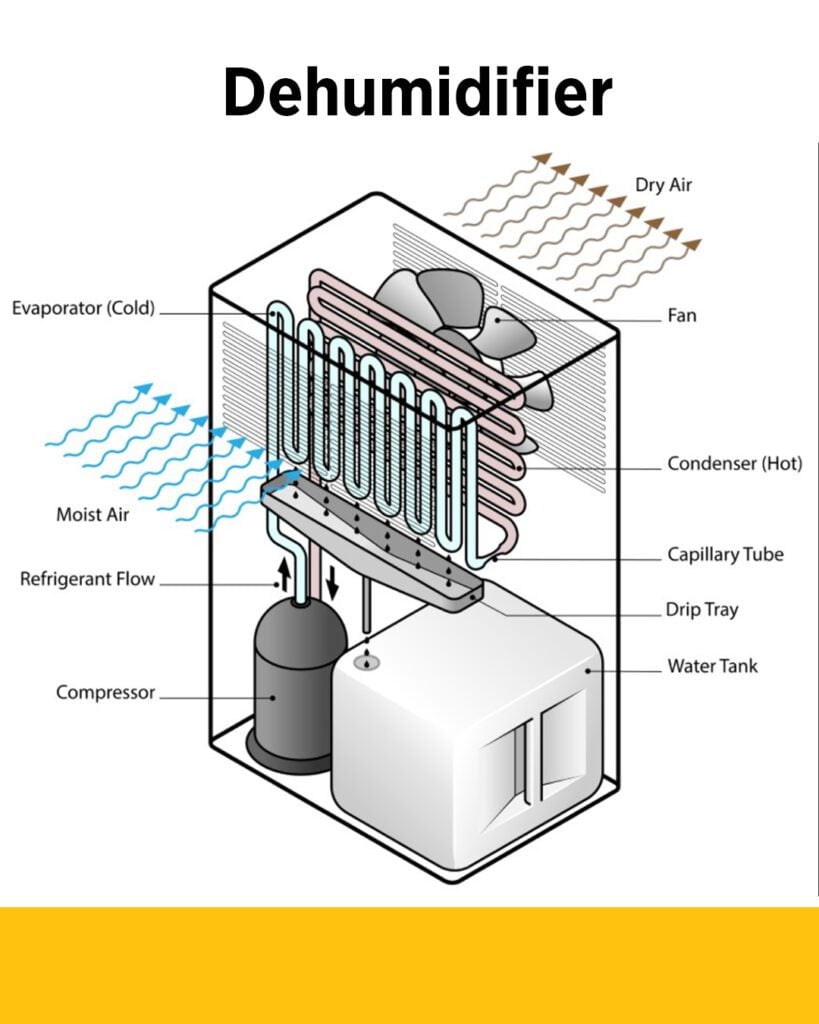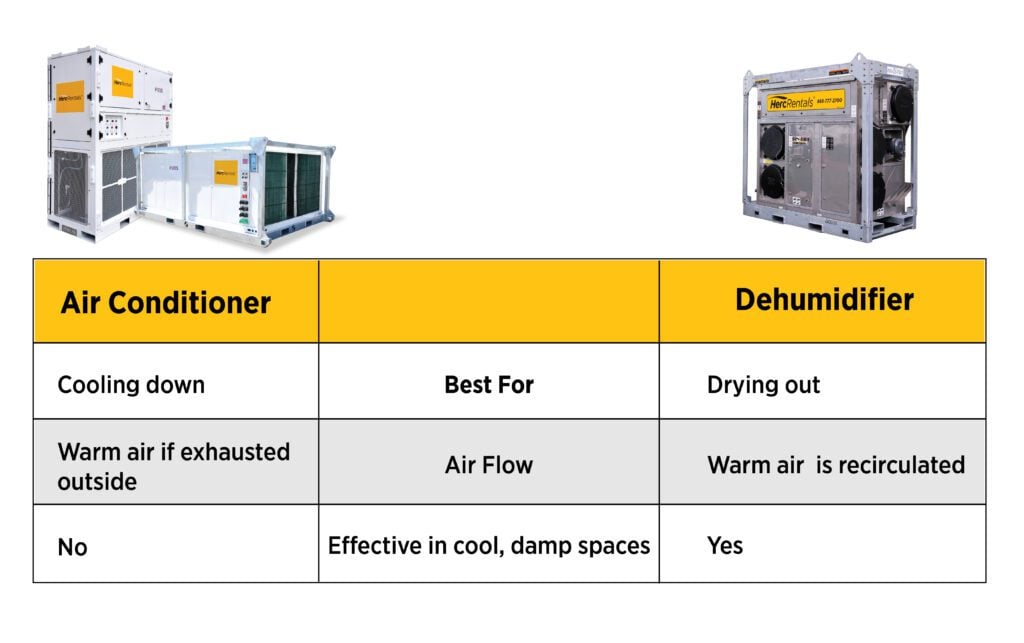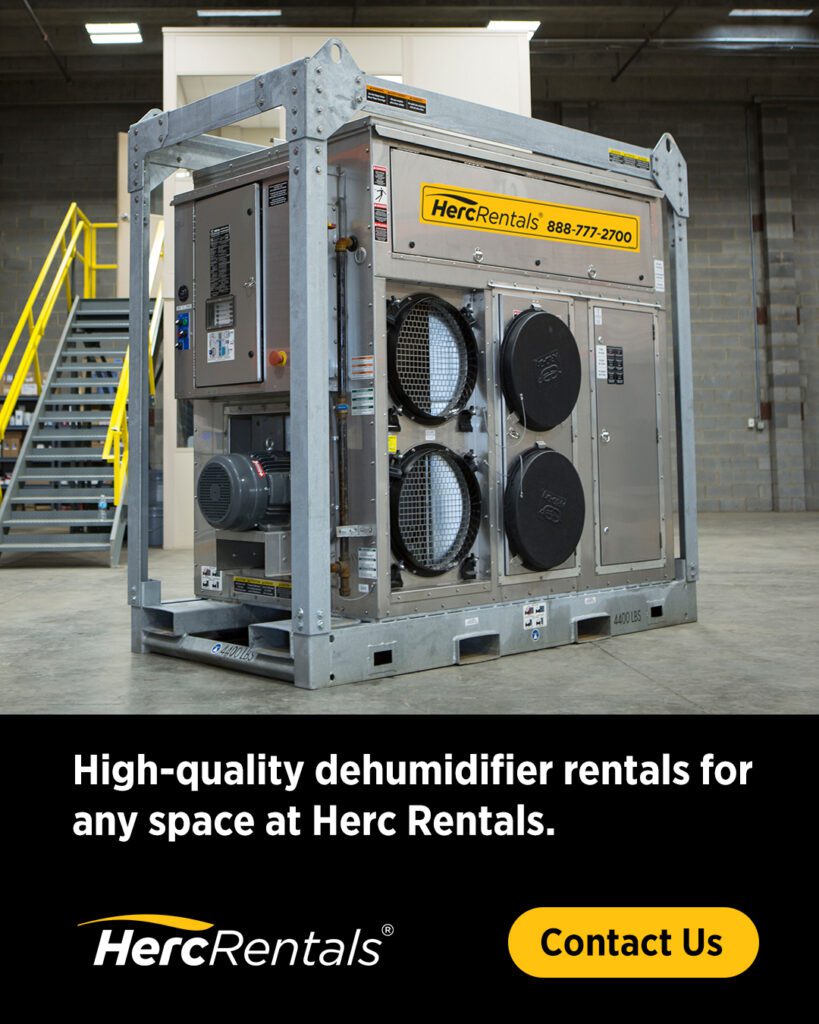Last Updated on October 22, 2025 by hercrentals
“It’s not the heat, it’s the humidity!” This is a common complaint whenever and wherever the atmosphere gets hot and muggy during the summer. The air feels sticky, and you feel way more uncomfortable than you would in a drier region.
When our body temperatures exceed 98.6 degrees, we start to sweat. In low humidity (such as in the desert), the sweat evaporates off your skin right away, cooling you off.
When it’s humid, sweat can’t evaporate. As clothes and hair get damp, you can overheat. Excess humidity doesn’t just feel uncomfortable on your skin, either. It’s the perfect breeding ground for mildew and mold on furniture, inside buildings and on a variety of materials.
So, how can you keep your facility and people comfortable? How do you know when you need an air conditioner (AC) versus a dehumidifier?
In this article, you’ll learn how to reduce humidity in your building and when to get a dehumidifier.
Quick Answer: Does an Air Conditioner Dehumidify?
Yes — but not all the time or for every scenario.
AC units can help reduce humidity, prevent moisture from entering through open windows and doors, and keep the temperature of a room cool. But they aren’t very efficient at removing excess moisture from the air.
Dehumidifiers are much more efficient at removing excess moisture. This is especially true when:
- The temperature of the room is already low or comfortable.
- There is a lot of moisture in the air, such as in a wet basement or indoor pool facility.
Keep reading to understand when a dehumidifier can help keep cool.

How to Remove Humidity and Improve Indoor Air Quality
Dehumidifying is the process of removing moisture (water) from the air. There are a few types of climate control equipment that can help, including traditional air conditioning units, desiccant dehumidifiers and modern HVAC systems. They all work by pulling warm, moist air into the unit and releasing cool, dry air into the facility.
1. Desiccant Dehumidifiers
Dehumidifiers are designed to remove moisture regardless of the air’s temperature. Their main focus is drying the air, not cooling it.
Dehumidifiers work by drawing humid air across a refrigerant-cooled evaporator coil. This cools the air a bit as it continues across the heated condenser coil. This temperature changing process pulls moisture out of the air, collecting it in a water tank. The dry air is then returned to the room.
Desiccant dehumidifiers are a type of dehumidifier that use moisture-absorbing materials (instead of refrigerants) to pull humidity from the air. This makes them especially effective in cooler environments.
- Best For Removing Moisture: Dehumidifiers are best for use in cool temperatures and industrial or commercial spaces. Dehumidifiers are especially necessary for areas with specific moisture-control requirements.
- Learn More: How Do Desiccant Dehumidifiers Work?

2. Air Conditioning Units or Portable Air Conditioning Units
The same components found in a dehumidifier are also used in air conditioning. Like a dehumidifier, air conditioners also use an evaporator, compressor, condenser and metering device.
When an AC unit cools the air, it removes some moisture, but not all of it. Its primary goal, however, is temperature control, not moisture removal.
- Best For Cooling: Homes and indoor spaces where you need to cool the air more than you need to control moisture.

3. Modern HVAC Systems
Modern HVAC systems may incorporate both cooling and dehumidifying functions. However, their effectiveness still depends on the scale of the space and its specific requirements.
You may still need a portable desiccant dehumidifier or spot cooler to handle a heatwave. They’re also helpful in getting materials to cure faster or to keep moisture away from sensitive materials.
Modern HVAC systems use evaporator coils. The coils cause moisture to condense and leave the air. As the moist, hot air contacts the cold coil, water collects on the cooling coils and slides outside. The cooled air is pushed into the room.
- Best For Facility-Wide Climate Control: Modern HVAC systems are a part of the building itself, so they are best for everyday facility-wide climate control needs.
AC, Dehumidifier… What’s the Difference?
At a glance, air conditioners and dehumidifiers might seem similar. They both remove humidity and use many of the same components. But their goals and methods differ significantly.
Cooling vs. Moisture Control:
AC units are designed to lower a room’s temperature. To do so, they cool the air enough to cause condensation. Then, warm air is exhausted outside. AC units are best at keeping a space cool.
Dehumidifiers only need to cool the air a bit before reheating it and returning it to the room. They are best at keeping a room dry.
Heat Exhaust vs. Reintroduction:
Because AC units are trying to reduce temperature, they exhaust the hot air outdoors.
Dehumidifiers, however, recycle the heat and dry air back into the room.
Use in Warm Temperatures vs. Cool, Damp Spaces:
ACs are activated by heat, so they run when temperatures rise, regardless of moisture.
Dehumidifiers, on the other hand, are activated by humidity levels. This makes them ideal for cold, damp environments like basements and underground facilities where AC units may not even turn on.
In spaces with persistent moisture, such as storage areas, crawlspaces or manufacturing rooms, using only an AC unit won’t be enough to mitigate the moisture. Without a dehumidifier, you risk long-term humidity-related problems.

5 Reasons to Use a Dehumidifier
There are several times when a dehumidifier or desiccant dehumidifier is the best choice for keeping your space dry and comfortable.
- There’s more humidity than your AC unit can handle. If your AC is struggling to pull enough moisture out of the air, a dehumidifier will help keep your space more comfortable.
- The space is already cool, but it’s damp. Many basements are both cold and damp. For these areas, an AC unit a poor choice for keeping it dry. Some facilities also need humidity control year-round, even in winter. Using a dehumidifier is a better choice for keeping the air dry when it’s already cold.
- You need climate control without the expense of an AC system. If your area never gets too hot, and you don’t want the hassle and energy costs of an AC or HVAC system, combining fans with a dehumidifier can be a cost-effective way to keep a space comfortable.
- Materials need to cure or the space needs to dry out. Maybe a burst pipe or bad weather increased the indoor humidity. Or, you need paint, adhesives and cement to cure quickly. Desiccant dehumidifiers can play a pivotal role in reducing moisture damage. This helps in keeping your project on schedule and maintaining your equipment.
- You need to meet air quality standards and keep teams comfortable. OSHA requires employers to provide a safe and healthy workplace. Maintaining good indoor air quality is part of that responsibility. Excess humidity can contribute to unsafe working conditions. How? Moisture encourages mold growth and reduces air quality.
- Learn More: OSHA Indoor Air Quality Standards
Humidity is No Match for a Dehumidifier from Herc Rentals
A dehumidifier can eliminate dampness from the air. Overall, this helps to keep people comfortable and materials from corroding. Whether you need to dry out a damp storage room, maintain quality in a production facility or protect your workspace from excessive moisture, Herc Rentals has you covered.
Our high-performance desiccant dehumidifiers and climate control solutions are designed for reliability and efficiency in both commercial and industrial applications. Our portable desiccant dehumidifiers help you manage fluctuating humidity nearly anywhere in your facility.
Plus, when you rent climate control equipment from Herc Rentals, you’ll get access to the latest technology, expert support and flexible rental terms to meet your project’s unique needs. It’s possible that you need an AC unit and a dehumidifier to work in tandem for the ideal climate control solution.
Explore our full line of dehumidifiers and climate control equipment now. You can also call 1-800-432-6215 to discuss options with an expert today.



